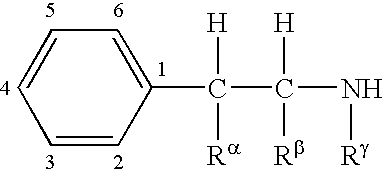Combination therapy for effecting weight loss and treating obesity
a combination therapy and weight loss technology, applied in the field of combination therapy for treating obesity, can solve the problems of serious and often life-threatening medical problems caused by overweight and obesity, obesity and overweight substantially increase the risk of morbidity from hypertension, and achieve the effects of reducing blood pressure, lowering blood lipids, and improving sleep apnea
- Summary
- Abstract
- Description
- Claims
- Application Information
AI Technical Summary
Benefits of technology
Problems solved by technology
Method used
Image
Examples
example 1
[0057]Patients as part of the following trial were treated according to the following dosage regimen. Patients took phentermine at a dose of 15 mg daily throughout the weight loss program, before breakfast. For the first 6 days, patients took one 25 mg tablet of topiramate before supper. For the next 6 days, patients took two 25 mg tablets of topiramate before supper. For the next 7 days (days 13-19), patients took 100 mg before supper daily using 4-25 mg tablets of topiramate daily. For days 20-26, patients took 150 mg of topiramate daily consisting of one-half of a 200 mg tablet and two 25-mg mg tablets of topiramate. From that point on, unless instructed otherwise by the physician, patients continued to take one 200 mg topiramate tablet daily before supper and continued the 15 mg phentermine daily in the morning. Patients were advised to drink at least eight (8) full glasses of water daily to reduce the risk of kidney stones which may result from taking topiramate.
[0058]Patients ...
example 2
[0062]Extended results of the trial described in Example 1.
[0063]A total of thirteen patients were treated for 1-9 months with phentermine (15 mg daily) in the morning and up to 400 mg of topiramate (median dose 200 mg), in the evening. [Note: Patient D.M.(B) discussed above is not included in this data as he was on phentermine treatment prior to treatment with the combination therapy of the present invention.] Topiramate dose was gradually increased from 25 mg per day in increments of 25-50 mg weekly until either desirable weight loss took place or until side effects limited dose increases. [Note: A fourteenth patient discontinued treatment after 3 days due to nausea.] All thirteen patients tolerated treatment well with minimal side effects. Along with taking medication, patients were instructed to walk at least 30 minutes three times per week and to follow a low fat diet. No patients had taken diet medication for at least 3 months prior to treatment. Average baseline BMI was 32.5 ...
example 3
[0071]The 56-year old male patient described previously (D.M.(B)) who was initially taking phentermine alone and had topiramate added to his regimen had a good effect from the combination. He once weighed as much as 395 pounds. When Redux was still on the mark in the United States, he was treated with a combination of diet, exercise, Redux and phentermine. His lowest weight attained was 285 pounds. When Redux was withdrawn from the market, he remained on phentermine but gained weight back to 295-300 pounds. When topiramate was added to his regimen, he managed to lose 25 pounds and is currently at 271 pounds, his lowest weight since he was in his 20s. He, along with most of the patients treated so far, reported that the treatment with topiramate and phentermine had fewer side effects and was more effective than any previous weight loss treatment using medications that he and others had tried. This 56-year old man exhibited lowered blood pressure (approx. 15 mm Hg systolic and 10 mm H...
PUM
| Property | Measurement | Unit |
|---|---|---|
| weight loss | aaaaa | aaaaa |
| time | aaaaa | aaaaa |
| weight loss | aaaaa | aaaaa |
Abstract
Description
Claims
Application Information
 Login to View More
Login to View More - R&D
- Intellectual Property
- Life Sciences
- Materials
- Tech Scout
- Unparalleled Data Quality
- Higher Quality Content
- 60% Fewer Hallucinations
Browse by: Latest US Patents, China's latest patents, Technical Efficacy Thesaurus, Application Domain, Technology Topic, Popular Technical Reports.
© 2025 PatSnap. All rights reserved.Legal|Privacy policy|Modern Slavery Act Transparency Statement|Sitemap|About US| Contact US: help@patsnap.com



